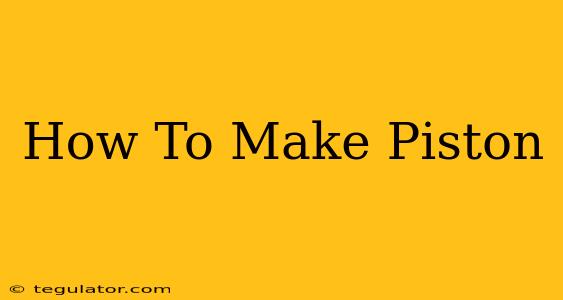Making a piston, whether for a model engine or a larger project, requires precision and a good understanding of machining techniques. This guide outlines the process, emphasizing safety precautions and essential tools. Remember, creating a functional piston requires significant skill and the right equipment. This guide provides a conceptual overview, not a definitive how-to for beginners.
Understanding Piston Design and Function
Before diving into the manufacturing process, let's understand the fundamental design and function of a piston. A piston is a cylindrical component that moves reciprocally (back and forth) within a cylinder. It's driven by the expansion of gases (like in an internal combustion engine) or hydraulic pressure (like in a hydraulic pump). Key features include:
- Crown: The top surface of the piston, designed to withstand high pressure and heat.
- Rings: Fitted into grooves in the piston, these rings seal the combustion chamber and prevent leakage.
- Piston Skirt: The cylindrical part of the piston that slides within the cylinder.
- Piston Pin (Wrist Pin): Connects the piston to the connecting rod.
Tools and Materials Required
Creating a piston requires specialized tools and materials, including:
- Lathe: Essential for shaping the cylindrical body of the piston.
- Milling Machine: Needed for precise machining of the piston crown and other features.
- Grinding Machine: Used for finishing and ensuring precise tolerances.
- Measuring Instruments: Calipers, micrometers, and dial indicators are crucial for accurate measurements.
- Appropriate Metal Stock: The choice of material (aluminum alloy, cast iron, etc.) depends on the application and performance requirements.
- Cutting Tools: Various drills, reamers, and cutting bits are required for different machining operations.
- Safety Gear: Eye protection, ear protection, and appropriate clothing are absolutely essential.
Step-by-Step Manufacturing Process (Conceptual Overview)
This section provides a simplified overview of the process. The exact steps and techniques will vary depending on the design and available equipment.
1. Material Preparation
Begin by preparing the metal stock. This might involve cutting it to the approximate size and shape needed.
2. Rough Turning on the Lathe
The lathe is used to create the basic cylindrical shape of the piston skirt. This is a rough machining process, removing large amounts of material.
3. Machining the Piston Crown
The milling machine is crucial for machining the piston crown to its final shape and dimensions. This requires precision and careful planning.
4. Creating Piston Ring Grooves
The lathe or milling machine can be used to cut the grooves for the piston rings. The precise depth and width of these grooves are critical for proper ring sealing.
5. Drilling the Piston Pin Hole
The piston pin hole must be accurately drilled and reamed to ensure a tight fit with the piston pin. Bore size needs to be extremely precise.
6. Finishing and Inspection
This involves grinding, polishing, and inspecting the piston for any imperfections or deviations from the design specifications. This step is critical for ensuring a properly functioning piston.
Safety First!
Always prioritize safety. Wear appropriate safety gear at all times when working with machinery and sharp tools. Incorrect procedures could lead to serious injury. Consult a professional machinist if you are inexperienced with machine operation.
Conclusion
Making a piston is a challenging project that requires significant skill, precision, and specialized equipment. This guide provides a general overview, highlighting the essential steps involved. Remember that this is a complex process and should only be attempted by experienced machinists. Always consult professional resources and prioritize safety.

